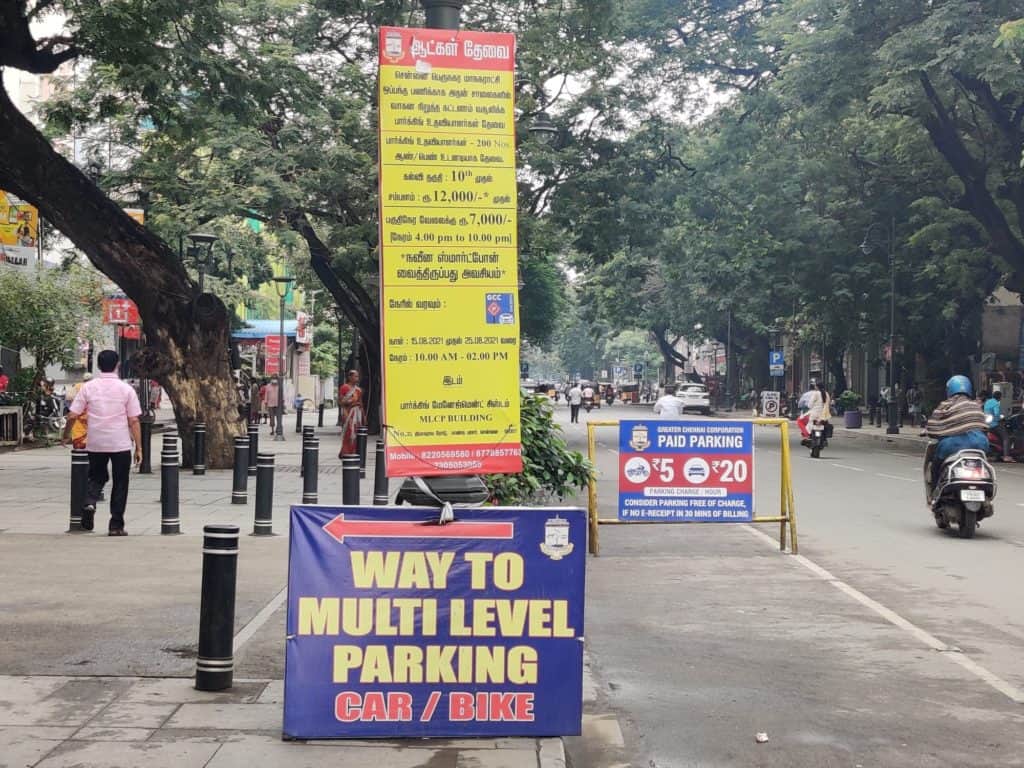Chennai’s swirling mass of two-wheelers and cars could technically make the Greater Chennai Corporation a wealthy civic body through parking fees, but the current realisation of revenues is only of the order of Rs.1.2 lakh a day, going up from a low Rs.80,000 after parking lots were “improved.”
The GCC plans to double the number of street parking sites to 88 locations and provide 12,000 spaces.As of April 2021, there were 9.99 lakh cars and 49 lakh two-wheelers registered in the State capital as per official data.
For Tamil Nadu as a whole, the vehicle population grew sharply since 2001, with two-wheelers jumping from 11 lakh in 2001 to 1.69 crore in 2021. Cars registered soared from over 4 lakh to about 29 lakh in this period. This should ring the cash registers for local bodies, but the State government and municipalities ignored the opportunity.
Value of parking charges in Chennai
Just how valuable parking is for revenues was recently highlighted in a case filed by a cinema theatre in the Madras High Court, and the court ruled on August 12 in favour of the theatre. It ordered that the State government’s cap on parking fees at such venues be revised from Rs.20 (for cars in Corporations, Special Grade Municipalities), since the rates prevailing at Chennai Central Station, Flower Bazaar, T. Nagar and the city airport were much higher than this. The government regulates parking fees in cinemas under the Tamil Nadu Cinemas Regulation Rules, 1957, and the court order covered two-wheelers also (so far charging Rs.10).
Arguably, the highest inner-city rate charged for car parking is in the T. Nagar smart city pedestrian plaza at Rs.60 an hour, although the plaza is an oxymoron now since the road margins are chock full of cars. There is no word on the fate of the high-profile automated multi-level parking arrangement in the plaza.
Considerable revenue is also leaking along the pedestrian plaza, since enforcement is weak and some vehicles are illegally parked beyond the charging area, closer to Panagal Park.Two-wheelers are strewn all over, on the pedestrian paths and connecting roads. Hotels have earmarked pedestrian spaces for their patrons’ parking. Not everyone pays the Rs.15 per hour prescribed for two-wheelers. The Right of Way for buses has been severely hit by the present arrangement of cars lining both sides of the plaza.
Read more: Street parking to be charged soon in city: Raj Cherubal, CEO, CSCL
Attitudes to paid parking in Chennai
Many urban residents now use cars, besides the large number of middle class residents using two-wheelers, reflected in the official vehicle growth numbers. Indicatively, if 5% of the cars registered in Chennai (50,000) used a parking space once a day, and paid a fee equivalent to that charged by cinema theatres, it should send Rs.10 lakh into the coffers of the GCC every day. A fraction of the two-wheelers, at 10,00,000 out of the 49 lakh, paying Rs.10 each, would raise a handsome Rs.1 crore a day.
The real payments from street parking would naturally be higher, since thousands of cars park on public streets, often round-the-clock, obstructing movement of people. Regulating this parking arrangement by earmarking non-controversial spaces (on the Bogota model of Enrique Penelosa) and charging a suitable fee is more low hanging fruit.
So important is real estate to park cars that several jewellery and textile shops in T. Nagar have purchased or leased prime land that costs upwards of Rs. 20,000 a square foot as exclusive parking lots for clients.
With broader revenue streams like parking brought under regulation, Tamil Nadu’s Finance Minister P.T.R. Palanivel Rajan can find the funds he needs more easily to expand public transport and walkability that matches developed country standards. The Minister often speaks of the need to boost public transport, particularly buses, with a welfare mindset, and the DMK government’s fare-free travel for women is a big hit.
Higher revenues would help maintain pedestrian facilities in shopping areas, so vital to business.The State government can also inventorise parking currently available, which could grow private parking as a commercial proposition.
Read more: All is not well at the T Nagar Pedestrian Plaza
Tech solutions for parking
Bringing order to urban chaos is every Indian city’s goal, and parking plays a major part in people reclaiming streets and walking spaces. International parking expert Paul Barter who has studied India’s problems and made remedial suggestions, writes that cities addressing the problem afresh could find digital technologies such as GPS-based systems and smart metering with multiple payment options attractive.
Parking enforcement could provide many more job opportunities in an increasingly stressed job market.The State government can also inventorise parking currently available, which could grow private parking as a commercial propositionIn the Indian context, non-contact, non-discretionary transactions remove bottlenecks and seepage of revenues.
Here, could the Fastag RFIDs fixed to cars be integrated with local parking systems, to auto-debit a vehicle entering a specific zone or space? Since the Union government is talking of removing Fastag systems for tolls, they could readily find a different use in the urban context through parking payments.The National Urban Transport Policy (NUTP) already mandates that a high parking fee reflecting the value of the land occupied be levied, which would have the additional benefit of promoting public transport.
Parking systems in Chennai and major Tamil Nadu cities have had a rollercoaster ride, with one previous government allowing streets to be carved up by local mafias as a rent collection opportunity, and another removing all paid parking in public streets. Mr. Palanivel Rajan is looking at a cash register that needs a major upgrade without delay.
[This story was first published in Inmathi.com and has been republished with permission. The original article can be found here.]
